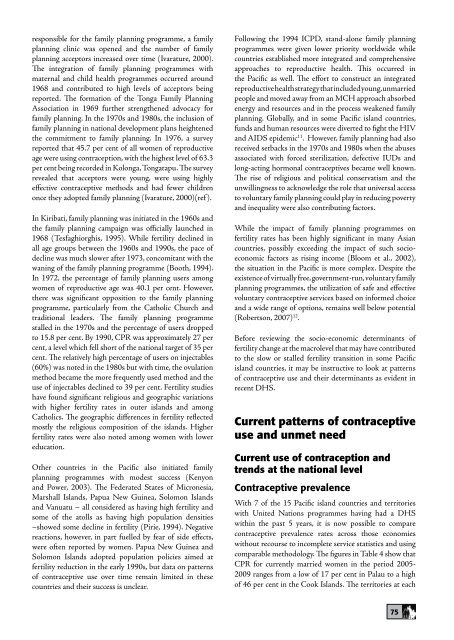Family Planning in Asia and the Pacific - International Council on ...
Family Planning in Asia and the Pacific - International Council on ...
Family Planning in Asia and the Pacific - International Council on ...
You also want an ePaper? Increase the reach of your titles
YUMPU automatically turns print PDFs into web optimized ePapers that Google loves.
esp<strong>on</strong>sible for <str<strong>on</strong>g>the</str<strong>on</strong>g> family plann<str<strong>on</strong>g>in</str<strong>on</strong>g>g programme, a familyplann<str<strong>on</strong>g>in</str<strong>on</strong>g>g cl<str<strong>on</strong>g>in</str<strong>on</strong>g>ic was opened <str<strong>on</strong>g>and</str<strong>on</strong>g> <str<strong>on</strong>g>the</str<strong>on</strong>g> number of familyplann<str<strong>on</strong>g>in</str<strong>on</strong>g>g acceptors <str<strong>on</strong>g>in</str<strong>on</strong>g>creased over time (Ivarature, 2000).The <str<strong>on</strong>g>in</str<strong>on</strong>g>tegrati<strong>on</strong> of family plann<str<strong>on</strong>g>in</str<strong>on</strong>g>g programmes withmaternal <str<strong>on</strong>g>and</str<strong>on</strong>g> child health programmes occurred around1968 <str<strong>on</strong>g>and</str<strong>on</strong>g> c<strong>on</strong>tributed to high levels of acceptors be<str<strong>on</strong>g>in</str<strong>on</strong>g>greported. The formati<strong>on</strong> of <str<strong>on</strong>g>the</str<strong>on</strong>g> T<strong>on</strong>ga <str<strong>on</strong>g>Family</str<strong>on</strong>g> <str<strong>on</strong>g>Plann<str<strong>on</strong>g>in</str<strong>on</strong>g>g</str<strong>on</strong>g>Associati<strong>on</strong> <str<strong>on</strong>g>in</str<strong>on</strong>g> 1969 fur<str<strong>on</strong>g>the</str<strong>on</strong>g>r streng<str<strong>on</strong>g>the</str<strong>on</strong>g>ned advocacy forfamily plann<str<strong>on</strong>g>in</str<strong>on</strong>g>g. In <str<strong>on</strong>g>the</str<strong>on</strong>g> 1970s <str<strong>on</strong>g>and</str<strong>on</strong>g> 1980s, <str<strong>on</strong>g>the</str<strong>on</strong>g> <str<strong>on</strong>g>in</str<strong>on</strong>g>clusi<strong>on</strong> offamily plann<str<strong>on</strong>g>in</str<strong>on</strong>g>g <str<strong>on</strong>g>in</str<strong>on</strong>g> nati<strong>on</strong>al development plans heightened<str<strong>on</strong>g>the</str<strong>on</strong>g> commitment to family plann<str<strong>on</strong>g>in</str<strong>on</strong>g>g. In 1976, a surveyreported that 45.7 per cent of all women of reproductiveage were us<str<strong>on</strong>g>in</str<strong>on</strong>g>g c<strong>on</strong>tracepti<strong>on</strong>, with <str<strong>on</strong>g>the</str<strong>on</strong>g> highest level of 63.3per cent be<str<strong>on</strong>g>in</str<strong>on</strong>g>g recorded <str<strong>on</strong>g>in</str<strong>on</strong>g> Kol<strong>on</strong>ga, T<strong>on</strong>gatapu. The surveyrevealed that acceptors were young, were us<str<strong>on</strong>g>in</str<strong>on</strong>g>g highlyeffective c<strong>on</strong>traceptive methods <str<strong>on</strong>g>and</str<strong>on</strong>g> had fewer children<strong>on</strong>ce <str<strong>on</strong>g>the</str<strong>on</strong>g>y adopted family plann<str<strong>on</strong>g>in</str<strong>on</strong>g>g (Ivarature, 2000)(ref ).In Kiribati, family plann<str<strong>on</strong>g>in</str<strong>on</strong>g>g was <str<strong>on</strong>g>in</str<strong>on</strong>g>itiated <str<strong>on</strong>g>in</str<strong>on</strong>g> <str<strong>on</strong>g>the</str<strong>on</strong>g> 1960s <str<strong>on</strong>g>and</str<strong>on</strong>g><str<strong>on</strong>g>the</str<strong>on</strong>g> family plann<str<strong>on</strong>g>in</str<strong>on</strong>g>g campaign was officially launched <str<strong>on</strong>g>in</str<strong>on</strong>g>1968 (Tesfaghiorghis, 1995). While fertility decl<str<strong>on</strong>g>in</str<strong>on</strong>g>ed <str<strong>on</strong>g>in</str<strong>on</strong>g>all age groups between <str<strong>on</strong>g>the</str<strong>on</strong>g> 1960s <str<strong>on</strong>g>and</str<strong>on</strong>g> 1990s, <str<strong>on</strong>g>the</str<strong>on</strong>g> pace ofdecl<str<strong>on</strong>g>in</str<strong>on</strong>g>e was much slower after 1973, c<strong>on</strong>comitant with <str<strong>on</strong>g>the</str<strong>on</strong>g>wan<str<strong>on</strong>g>in</str<strong>on</strong>g>g of <str<strong>on</strong>g>the</str<strong>on</strong>g> family plann<str<strong>on</strong>g>in</str<strong>on</strong>g>g programme (Booth, 1994).In 1972, <str<strong>on</strong>g>the</str<strong>on</strong>g> percentage of family plann<str<strong>on</strong>g>in</str<strong>on</strong>g>g users am<strong>on</strong>gwomen of reproductive age was 40.1 per cent. However,<str<strong>on</strong>g>the</str<strong>on</strong>g>re was significant oppositi<strong>on</strong> to <str<strong>on</strong>g>the</str<strong>on</strong>g> family plann<str<strong>on</strong>g>in</str<strong>on</strong>g>gprogramme, particularly from <str<strong>on</strong>g>the</str<strong>on</strong>g> Catholic Church <str<strong>on</strong>g>and</str<strong>on</strong>g>traditi<strong>on</strong>al leaders. The family plann<str<strong>on</strong>g>in</str<strong>on</strong>g>g programmestalled <str<strong>on</strong>g>in</str<strong>on</strong>g> <str<strong>on</strong>g>the</str<strong>on</strong>g> 1970s <str<strong>on</strong>g>and</str<strong>on</strong>g> <str<strong>on</strong>g>the</str<strong>on</strong>g> percentage of users droppedto 15.8 per cent. By 1990, CPR was approximately 27 percent, a level which fell short of <str<strong>on</strong>g>the</str<strong>on</strong>g> nati<strong>on</strong>al target of 35 percent. The relatively high percentage of users <strong>on</strong> <str<strong>on</strong>g>in</str<strong>on</strong>g>jectables(60%) was noted <str<strong>on</strong>g>in</str<strong>on</strong>g> <str<strong>on</strong>g>the</str<strong>on</strong>g> 1980s but with time, <str<strong>on</strong>g>the</str<strong>on</strong>g> ovulati<strong>on</strong>method became <str<strong>on</strong>g>the</str<strong>on</strong>g> more frequently used method <str<strong>on</strong>g>and</str<strong>on</strong>g> <str<strong>on</strong>g>the</str<strong>on</strong>g>use of <str<strong>on</strong>g>in</str<strong>on</strong>g>jectables decl<str<strong>on</strong>g>in</str<strong>on</strong>g>ed to 39 per cent. Fertility studieshave found significant religious <str<strong>on</strong>g>and</str<strong>on</strong>g> geographic variati<strong>on</strong>swith higher fertility rates <str<strong>on</strong>g>in</str<strong>on</strong>g> outer isl<str<strong>on</strong>g>and</str<strong>on</strong>g>s <str<strong>on</strong>g>and</str<strong>on</strong>g> am<strong>on</strong>gCatholics. The geographic differences <str<strong>on</strong>g>in</str<strong>on</strong>g> fertility reflectedmostly <str<strong>on</strong>g>the</str<strong>on</strong>g> religious compositi<strong>on</strong> of <str<strong>on</strong>g>the</str<strong>on</strong>g> isl<str<strong>on</strong>g>and</str<strong>on</strong>g>s. Higherfertility rates were also noted am<strong>on</strong>g women with lowereducati<strong>on</strong>.O<str<strong>on</strong>g>the</str<strong>on</strong>g>r countries <str<strong>on</strong>g>in</str<strong>on</strong>g> <str<strong>on</strong>g>the</str<strong>on</strong>g> <str<strong>on</strong>g>Pacific</str<strong>on</strong>g> also <str<strong>on</strong>g>in</str<strong>on</strong>g>itiated familyplann<str<strong>on</strong>g>in</str<strong>on</strong>g>g programmes with modest success (Keny<strong>on</strong><str<strong>on</strong>g>and</str<strong>on</strong>g> Power, 2003). The Federated States of Micr<strong>on</strong>esia,Marshall Isl<str<strong>on</strong>g>and</str<strong>on</strong>g>s, Papua New Gu<str<strong>on</strong>g>in</str<strong>on</strong>g>ea, Solom<strong>on</strong> Isl<str<strong>on</strong>g>and</str<strong>on</strong>g>s<str<strong>on</strong>g>and</str<strong>on</strong>g> Vanuatu – all c<strong>on</strong>sidered as hav<str<strong>on</strong>g>in</str<strong>on</strong>g>g high fertility <str<strong>on</strong>g>and</str<strong>on</strong>g>some of <str<strong>on</strong>g>the</str<strong>on</strong>g> atolls as hav<str<strong>on</strong>g>in</str<strong>on</strong>g>g high populati<strong>on</strong> densities–showed some decl<str<strong>on</strong>g>in</str<strong>on</strong>g>e <str<strong>on</strong>g>in</str<strong>on</strong>g> fertility (Pirie, 1994). Negativereacti<strong>on</strong>s, however, <str<strong>on</strong>g>in</str<strong>on</strong>g> part fuelled by fear of side effects,were often reported by women. Papua New Gu<str<strong>on</strong>g>in</str<strong>on</strong>g>ea <str<strong>on</strong>g>and</str<strong>on</strong>g>Solom<strong>on</strong> Isl<str<strong>on</strong>g>and</str<strong>on</strong>g>s adopted populati<strong>on</strong> policies aimed atfertility reducti<strong>on</strong> <str<strong>on</strong>g>in</str<strong>on</strong>g> <str<strong>on</strong>g>the</str<strong>on</strong>g> early 1990s, but data <strong>on</strong> patternsof c<strong>on</strong>traceptive use over time rema<str<strong>on</strong>g>in</str<strong>on</strong>g> limited <str<strong>on</strong>g>in</str<strong>on</strong>g> <str<strong>on</strong>g>the</str<strong>on</strong>g>secountries <str<strong>on</strong>g>and</str<strong>on</strong>g> <str<strong>on</strong>g>the</str<strong>on</strong>g>ir success is unclear.Follow<str<strong>on</strong>g>in</str<strong>on</strong>g>g <str<strong>on</strong>g>the</str<strong>on</strong>g> 1994 ICPD, st<str<strong>on</strong>g>and</str<strong>on</strong>g>-al<strong>on</strong>e family plann<str<strong>on</strong>g>in</str<strong>on</strong>g>gprogrammes were given lower priority worldwide whilecountries established more <str<strong>on</strong>g>in</str<strong>on</strong>g>tegrated <str<strong>on</strong>g>and</str<strong>on</strong>g> comprehensiveapproaches to reproductive health. This occurred <str<strong>on</strong>g>in</str<strong>on</strong>g><str<strong>on</strong>g>the</str<strong>on</strong>g> <str<strong>on</strong>g>Pacific</str<strong>on</strong>g> as well. The effort to c<strong>on</strong>struct an <str<strong>on</strong>g>in</str<strong>on</strong>g>tegratedreproductive health strategy that <str<strong>on</strong>g>in</str<strong>on</strong>g>cluded young, unmarriedpeople <str<strong>on</strong>g>and</str<strong>on</strong>g> moved away from an MCH approach absorbedenergy <str<strong>on</strong>g>and</str<strong>on</strong>g> resources <str<strong>on</strong>g>and</str<strong>on</strong>g> <str<strong>on</strong>g>in</str<strong>on</strong>g> <str<strong>on</strong>g>the</str<strong>on</strong>g> process weakened familyplann<str<strong>on</strong>g>in</str<strong>on</strong>g>g. Globally, <str<strong>on</strong>g>and</str<strong>on</strong>g> <str<strong>on</strong>g>in</str<strong>on</strong>g> some <str<strong>on</strong>g>Pacific</str<strong>on</strong>g> isl<str<strong>on</strong>g>and</str<strong>on</strong>g> countries,funds <str<strong>on</strong>g>and</str<strong>on</strong>g> human resources were diverted to fight <str<strong>on</strong>g>the</str<strong>on</strong>g> HIV<str<strong>on</strong>g>and</str<strong>on</strong>g> AIDS epidemic 11 . However, family plann<str<strong>on</strong>g>in</str<strong>on</strong>g>g had alsoreceived setbacks <str<strong>on</strong>g>in</str<strong>on</strong>g> <str<strong>on</strong>g>the</str<strong>on</strong>g> 1970s <str<strong>on</strong>g>and</str<strong>on</strong>g> 1980s when <str<strong>on</strong>g>the</str<strong>on</strong>g> abusesassociated with forced sterilizati<strong>on</strong>, defective IUDs <str<strong>on</strong>g>and</str<strong>on</strong>g>l<strong>on</strong>g-act<str<strong>on</strong>g>in</str<strong>on</strong>g>g horm<strong>on</strong>al c<strong>on</strong>traceptives became well known.The rise of religious <str<strong>on</strong>g>and</str<strong>on</strong>g> political c<strong>on</strong>servatism <str<strong>on</strong>g>and</str<strong>on</strong>g> <str<strong>on</strong>g>the</str<strong>on</strong>g>unwill<str<strong>on</strong>g>in</str<strong>on</strong>g>gness to acknowledge <str<strong>on</strong>g>the</str<strong>on</strong>g> role that universal accessto voluntary family plann<str<strong>on</strong>g>in</str<strong>on</strong>g>g could play <str<strong>on</strong>g>in</str<strong>on</strong>g> reduc<str<strong>on</strong>g>in</str<strong>on</strong>g>g poverty<str<strong>on</strong>g>and</str<strong>on</strong>g> <str<strong>on</strong>g>in</str<strong>on</strong>g>equality were also c<strong>on</strong>tribut<str<strong>on</strong>g>in</str<strong>on</strong>g>g factors.While <str<strong>on</strong>g>the</str<strong>on</strong>g> impact of family plann<str<strong>on</strong>g>in</str<strong>on</strong>g>g programmes <strong>on</strong>fertility rates has been highly significant <str<strong>on</strong>g>in</str<strong>on</strong>g> many <str<strong>on</strong>g>Asia</str<strong>on</strong>g>ncountries, possibly exceed<str<strong>on</strong>g>in</str<strong>on</strong>g>g <str<strong>on</strong>g>the</str<strong>on</strong>g> impact of such socioec<strong>on</strong>omicfactors as ris<str<strong>on</strong>g>in</str<strong>on</strong>g>g <str<strong>on</strong>g>in</str<strong>on</strong>g>come (Bloom et al., 2002),<str<strong>on</strong>g>the</str<strong>on</strong>g> situati<strong>on</strong> <str<strong>on</strong>g>in</str<strong>on</strong>g> <str<strong>on</strong>g>the</str<strong>on</strong>g> <str<strong>on</strong>g>Pacific</str<strong>on</strong>g> is more complex. Despite <str<strong>on</strong>g>the</str<strong>on</strong>g>existence of virtually free, government-run, voluntary familyplann<str<strong>on</strong>g>in</str<strong>on</strong>g>g programmes, <str<strong>on</strong>g>the</str<strong>on</strong>g> utilizati<strong>on</strong> of safe <str<strong>on</strong>g>and</str<strong>on</strong>g> effectivevoluntary c<strong>on</strong>traceptive services based <strong>on</strong> <str<strong>on</strong>g>in</str<strong>on</strong>g>formed choice<str<strong>on</strong>g>and</str<strong>on</strong>g> a wide range of opti<strong>on</strong>s, rema<str<strong>on</strong>g>in</str<strong>on</strong>g>s well below potential(Roberts<strong>on</strong>, 2007) 12 .Before review<str<strong>on</strong>g>in</str<strong>on</strong>g>g <str<strong>on</strong>g>the</str<strong>on</strong>g> socio-ec<strong>on</strong>omic determ<str<strong>on</strong>g>in</str<strong>on</strong>g>ants offertility change at <str<strong>on</strong>g>the</str<strong>on</strong>g> macrolevel that may have c<strong>on</strong>tributedto <str<strong>on</strong>g>the</str<strong>on</strong>g> slow or stalled fertility transiti<strong>on</strong> <str<strong>on</strong>g>in</str<strong>on</strong>g> some <str<strong>on</strong>g>Pacific</str<strong>on</strong>g>isl<str<strong>on</strong>g>and</str<strong>on</strong>g> countries, it may be <str<strong>on</strong>g>in</str<strong>on</strong>g>structive to look at patternsof c<strong>on</strong>traceptive use <str<strong>on</strong>g>and</str<strong>on</strong>g> <str<strong>on</strong>g>the</str<strong>on</strong>g>ir determ<str<strong>on</strong>g>in</str<strong>on</strong>g>ants as evident <str<strong>on</strong>g>in</str<strong>on</strong>g>recent DHS.Current patterns of c<strong>on</strong>traceptiveuse <str<strong>on</strong>g>and</str<strong>on</strong>g> unmet needCurrent use of c<strong>on</strong>tracepti<strong>on</strong> <str<strong>on</strong>g>and</str<strong>on</strong>g>trends at <str<strong>on</strong>g>the</str<strong>on</strong>g> nati<strong>on</strong>al levelC<strong>on</strong>traceptive prevalenceWith 7 of <str<strong>on</strong>g>the</str<strong>on</strong>g> 15 <str<strong>on</strong>g>Pacific</str<strong>on</strong>g> isl<str<strong>on</strong>g>and</str<strong>on</strong>g> countries <str<strong>on</strong>g>and</str<strong>on</strong>g> territorieswith United Nati<strong>on</strong>s programmes hav<str<strong>on</strong>g>in</str<strong>on</strong>g>g had a DHSwith<str<strong>on</strong>g>in</str<strong>on</strong>g> <str<strong>on</strong>g>the</str<strong>on</strong>g> past 5 years, it is now possible to comparec<strong>on</strong>traceptive prevalence rates across those ec<strong>on</strong>omieswithout recourse to <str<strong>on</strong>g>in</str<strong>on</strong>g>complete service statistics <str<strong>on</strong>g>and</str<strong>on</strong>g> us<str<strong>on</strong>g>in</str<strong>on</strong>g>gcomparable methodology. The figures <str<strong>on</strong>g>in</str<strong>on</strong>g> Table 4 show thatCPR for currently married women <str<strong>on</strong>g>in</str<strong>on</strong>g> <str<strong>on</strong>g>the</str<strong>on</strong>g> period 2005-2009 ranges from a low of 17 per cent <str<strong>on</strong>g>in</str<strong>on</strong>g> Palau to a highof 46 per cent <str<strong>on</strong>g>in</str<strong>on</strong>g> <str<strong>on</strong>g>the</str<strong>on</strong>g> Cook Isl<str<strong>on</strong>g>and</str<strong>on</strong>g>s. The territories at each75














